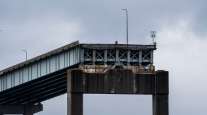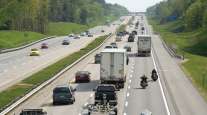Temporary I-5 Bridge Could Reopen in June

Washington state officials said they could have a temporary crossing in place by as soon as mid-June for the Interstate 5 bridge that collapsed late last week over the Skagit River, the Seattle Times reported.
DETOUR UDPATE: The Washington State Department of Transportation has updated its detour maps. Click here for northbound detour, or click here for the southbound detour.
The temporary fix will use steel girders with no trusses overhead, the newspaper reported, adding that a permanent fix could be in place by September.
The bridge’s trusses were struck by a truck carrying an oversized load Thursday night and a section of it collapsed, sending two vehicles, but not the truck, into the water. Several people were rescued, but no one was killed.
Meanwhile, U.S. Secretary of Transportation Ray LaHood announced that DOT will provide $1 million in immediate funding to help repair the span.
“We are doing everything possible to restore mobility as quickly as possible and expedite repairs,” LaHood said in a statement. The funding “represents a down payment on our commitment to the people of Washington.”
The 58-year-old Skagit River Bridge is in Mount Vernon, Wash., about halfway between Seattle and the Canadian border.
The temporary crossing’s four lanes will be narrower than the original structure, the speed limit will be reduced and oversized vehicles will not be allowed on the temporary span, the Times reported.
I-5 is the West Coast’s major north-south highway and more than 70,000 vehicles cross the bridge daily, including about 8,000 commercial trucks, according to the U.S. DOT.
About a third of cross-border traffic last year were Canadians crossing the Skagit River, or 1.9 million vehicle trips, the Times reported. About 70% of cross-border truck trips, equal to about $14 billion in imports and exports, end south of the Skagit River, the newspaper said.
Those trucks carry computer parts, vehicles, wood, iron and steel into British Columbia and bring back fish, aircraft components and finished goods, the Times reported.




